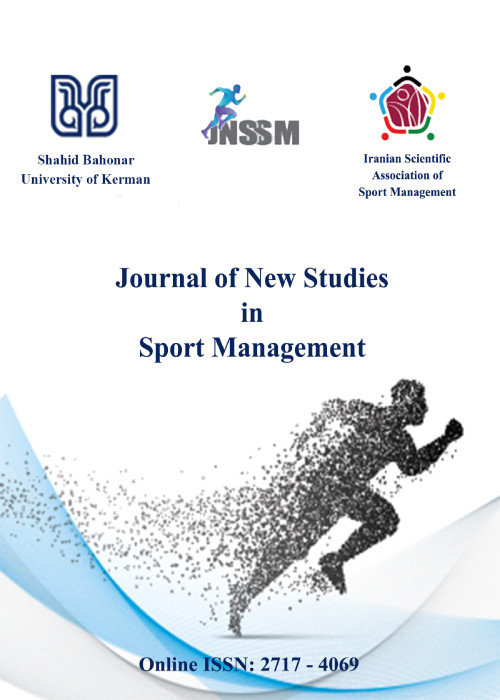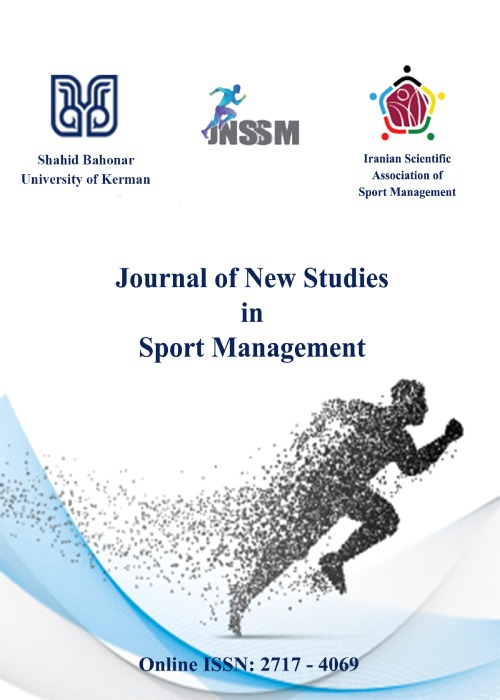فهرست مطالب

Journal of New Studies in Sport Management
Volume:4 Issue: 1, Winter 2023
- تاریخ انتشار: 1402/02/11
- تعداد عناوین: 6
-
-
Pages 654-675Spectators are the main element of football. Football, as a popular sport, has the capacity for the intimate involvement and intense emotional experiences of the spectators. But the large presence of spectators in one place increases the probability of critical situations. Therefore, the purpose of this study is to identify crowd crisis management (CCM) solutions in professional football and to select the best solutions in terms of functional priority with mix-method. In the qualitative part, the approach based on thematic analysis was used to identify the crowd crisis management solutions and in the quantitative part, the best-worst method (BWM) was used to determine the importance and weight of the identified factors. A semi-structured interviews with 21 experts and the implementation of the best-worst method, demonstrated that among the five categories of solutions related to CCM inside the stadium, control, and guide of spectators as the most important, and emergency medical services as the least important of solutions. Also, among the solutions for managing the crowd crisis outside the stadium, the staff training of the stadium is illustrated to be the most important and financial discipline the least important solution effective for controlling the crowd crisis. Therefore, it is suggested that organizers of the matches focus on solutions that lead to the accurate implementation of the roles and tasks of the groups involved in holding the match and the development of programs, policies and effective security measures to control the spectators.Keywords: Crisis Classification, Crisis Combat, Crisis Preparation, Crowd Crisis, Safety, Security
-
Pages 676-687
The purpose of the present article is to design indicators and variables that represent the value of volleyball players. This research method is applied, which was done in a quantitative and qualitative way. The research tool was a semi-structured interview with experts in the field of player valuation. In this research, the statistical population included all the experts and specialists in human resources and financial management issues in sports, and also volleyball experts. The sample size included a number of volleyball sports experts who expressed their ideas to determine the variables. A total of 60 variables were extracted, of which 40 are quantitative indicators and 20 are qualitative indicators. These indicators are not only effective in the selection of players, but can also determine the price and final value of the players.
Keywords: Human Resources, Valuation, Volleyball -
Pages 688-700The purpose of this study was to investigate the effect of market orientation on the job attitudes of employees in sports stores in Mazandaran, IRAN. This research was a descriptive-correlational and applied study. The statistical population consisted of all employees in Nike, Adidas, Reebok, Puma, and Majid sports store. Based on Structural Equation Modeling (SEM), the research sample included 200 subjects. Standard questionnaires were used for data collection. Linear regression and structural equation modeling (SEM) with Spss18 and Lisrel version 8.3 software have been used to investigate the research hypotheses. According to the research findings, market orientation affects employees' attitudes toward the sports stores and market orientation explains 69 percent of the variance of job attitudes. Moreover, market orientation components were effective on job satisfaction, organizational commitment, role conflict, and turnover intention. Market orientation components were also effective on job attitudes of the sports store employees. Therefore, the special attention to market orientation in promoting productivity, satisfaction and increasing commitment of employees, can be critical in achieving the goals and strategies of sports stores.Keywords: Job Attitude, Market Orientation, Role Conflict, Sports Stores, Turnover Intention
-
Pages 701-715
The present study brings forward a model of workplace health with an approach to staff’s physical activity improvement. this study was an applied and descriptive research that has been conducted with a mixed approach for data collection (qualitative and quantitative). The methodology is performed qualitatively on the basis of grounded theory of Glaser approach. The research participants in qualitative included 18 subjects selected through judgmental sampling method with snowball approach. In addition, the sample in quantitative section, 384 subjects were studied through convinience sampling based on Krejcie and Morgan table. The analysis in the quantitative section is second-order confirmatory factor analysis. According to the results, components of workplace health comprising the physical environment with sub-components of preparing infrastructure along with strenuous company; the psycho-social environment with sub-components of education, culturalization, encouragement along with support; the health resources with the sub-components of evaluation, supervision and alignment of plans; and participation of the company which comprises management and planning.
Keywords: grounded theory, Physical activity, Mobarakeh steel company, Workplace health -
Pages 716-726The present study was conducted with the aim of designing a model of barriers to the advancement of sports justice in schools of deprived areas with a mixed method. The present study was a sequential exploratory research and a survey one. The research population in the qualitative section included sports teachers in deprived areas that were purposefully selected for qualitative interviews (interviews with 15 participants until reaching the theoretical saturation). The research population of the quantitative section consisted of 181 sports teachers . The data collection tool in the present study was a semi-structured interview and a researcher-developed questionnaire. In order to analyze the research data, coding in the qualitative part and structural equation method in the quantitative part were conducted. In the qualitative part, 25 concept codes and 5 main categories were extracted. In the quantitative part, all 5 main extracted categories (economic, manpower, management, infrastructure, motivation) had a proper fitness.Keywords: Economic, Infrastructure, Management, Manpower, Motivation
-
Pages 727-739The present study was conducted with the aim of scenario planning of the future of strategic agility in the Ministry of Sports and Youth of the Islamic Republic of Iran through using future research. The method used in this research is scenario-based planning, which is designed and performed in eight steps. The method of data collection in this qualitative study was based on interview, expert panel and Delphi survey. Twenty experts with specialized knowledge or practical experience were selected as the participants of the research through using snowball sampling. In the first part, acceleration to affairs and processes, the application of new managerial competencies, innovative and agile organizational structure, the use of emerging technologies, and the existence of a system of encouragement and punishment based on strategic agility were identified as key drivers. In the second part, it identifies and describes possible and compatible scenarios based on the drivers and related uncertainties, and it was found that out of the two proposed scenarios, only one scenario is in a promising situation. According to this scenario, by increasing the speed of the affairs and processes, the use of new managerial competencies, agile organizational structure, emerging technologies, and the existence of an incentive system, we can see the improvement of strategic agility in the Ministry of Sports and Youth.Keywords: Foresight, Ministry of Sports, Youth, scenario planning, Strategic Agility


